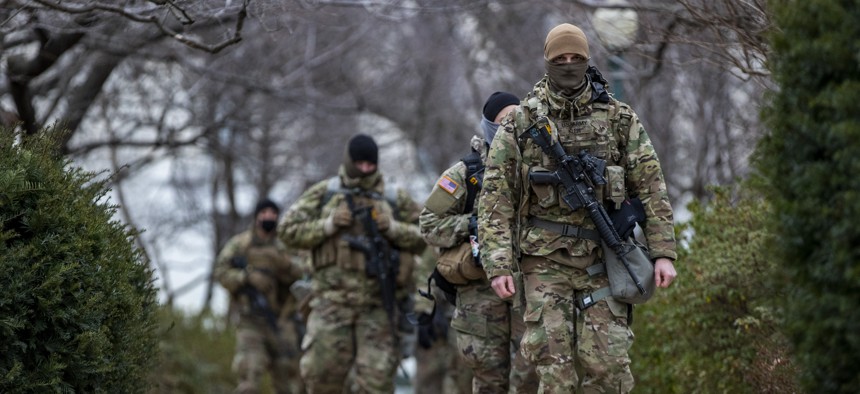
National Guard stand watch at the US Capitol on January 28, 2021, in Washington, DC. Tasos Katopodis/Getty Images
The Domestic Counterterrorism Strategy Is a Good Start—But Needs More
For at least three reasons, domestic CT strategy is harder than the international one that worked against al Qaeda.
The Biden Administration’s recently released domestic counterterrorism strategy has a lot going for it. As former counterterrorism senior officials with more than fifty years’ experience, we can see this was a strategy written by professionals, for professionals. So the new strategy is easy to praise—as far as it goes. However, given our experience, we also know how it could fall short.
The pillars of the strategy mirror previous efforts across administrations of both parties, which focused more on threats from overseas. Understanding the threat, preventing extremists from turning violent, and deterring and disrupting terrorist plots are core elements of strategies that reduced al-Qaeda and ISIS so that they no longer require massive U.S. military operations overseas.
However, the domestic terrorism threat is more difficult for three reasons.
First, domestic terrorism’s danger stems from ideologies with roots in divisive chapters of American history. Al-Qaeda’s and ISIS’s “grand strategy” was based on controlling people and territory in the Middle East, and saw U.S. and Western support for Mideast governments as their chief obstacle. It was comparatively easy for American leaders to unify the United States against al-Qaeda and ISIS, because attacks and plots were launched from abroad and most were led or directed by non-Americans. Unifying the country against white supremacism and violent strains of anti-government behavior that drove the January 6 attack on the Capitol will be harder—because the extremists are our fellow Americans.
Second, defeating terrorists abroad was largely the mission of the U.S. military and intelligence communities, supported by diplomacy, homeland security, and law enforcement. Defeating domestic terrorism is not a U.S. military mission, but will take coordination of law enforcement and homeland security departments, respect for constitutional rights, and will rely crucially on state and local governments, some of whose legislatures may not be fully committed to the cause.
Divided federal leadership is a third concern. Are the Attorney General and the Director of the FBI in charge of this campaign, the way the Secretary of Defense and the Director of the CIA led the campaign against al-Qaeda after 9/11? Military and civilian counterterrorism professionals—including the two of us—argued we could not just kill our way to victory against al-Qaeda and ISIS. Do we measure victory against domestic terrorism by the number of arrests—if not, what is the right metric for victory?
Third, this new strategy, while it has much good in it, doesn’t give a sense of the scale required for success. The Biden administration has already increased funding for investigators and prosecutors, and grants to state and local governments. But there is no sense how much it will take to achieve victory against domestic terrorism. It’s as if the United States answered the 1941 attack on Pearl Harbor by saying we would double the number of battleships. “Do more,” as the present strategy calls for, is often part of a good strategy, but it doesn’t say how much it will take to win the campaign.
So while there is much to praise in the new strategy, it needs critical thinking to identify the weak spots—to make sure that no one asks four years from now why such a promising strategy somehow failed.
The most important step sounds prosaic but is absolutely vital: this strategy will need more money and people to succeed. Additional funding will go a long way towards determining success. A good strategy alone doesn’t tell us victory’s sticker price.
The second danger is the distraction of false equivalency. We saw this in the demand to pair an investigation into the January 6 attack on the Capitol with an investigation into Antifa and the 2020 violence after the murder of George Floyd. While violent anarchists like Antifa attacked law enforcement and destroyed property, they are largely disorganized and fell short of attacks involving murders, bombings, and gun assaults committed by radical anti-government groups in the 1970s like the Weather Underground, Symbionese Liberation Army, and others. White supremacists and other like-minded violent extremists, on the other hand, are unquestionably responsible for more lethal attacks than any other ideological movement in the past decade—and as an attack on American democracy, nothing comes close to the January 6 attack on the Capitol.
The third danger—and by far the greatest—is a failure of imagination. A counterterrorism strategy written in 2000 would not have listed weaknesses in aviation security or visa policy, even though both led directly to 9/11. This new strategy is a solid effort to address the threat after January 6, but the threat has already changed as of mid-2021. We need much more attention, for example, on increased protection for key officials. Last fall's plot to kidnap Michigan Gov. Gretchen Whitmer shows this threat is real. When Congress, courts, and state houses are closely divided, domestic terrorists could try to change the course of history by targeting a few key elected leaders or Supreme Court justices. Missing from the strategy is increased protection for key members of Congress whose replacements could flip control of a chamber, or for jurists and state officials who are the subject of terrorists’ grievances. This would be the nightmare scenario for American democracy.
On balance, yesterday’s domestic counterterrorism strategy is an important first step forward—but releasing the strategy is the easy part. The hard work starts now.
NEXT STORY: The New Pentagon Slush Fund



